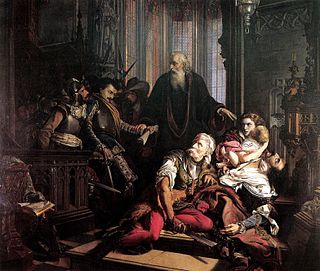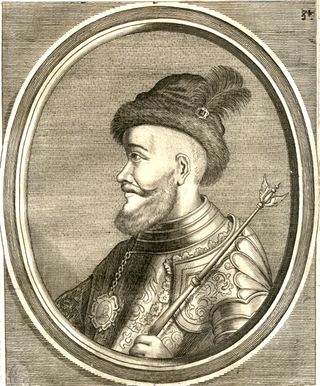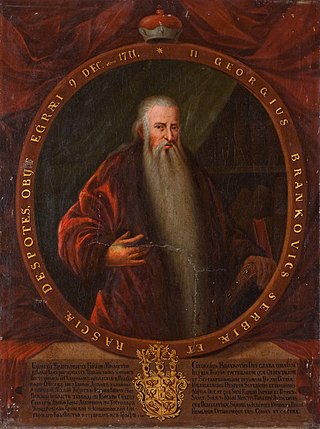Background
Until 1683, it stood at the peak of the Ottoman Empire's power in Hungary. Mihály I Apafi was promoted to princely position against János Kemény. In 1681, in exchange for abundant gifts, the Porta recognized the election of Michael Apafi as prince. However, in 1682, Sertar Pasha Ibrahim proclaimed Imre Thököly the prince of Hungary. In 1683, the Turks besieged Vienna, where the Transylvanian armies lined up alongside the Turks, yet it was feared that after the conquest of Vienna, the Turks would make Thököly the prince of Transylvania instead of Apafi. However, after the unsuccessful siege of Vienna, the Turkish fortunes of war reversed quickly and permanently, the imperial troops went into a counterattack and by 1684 they had already besieged Buda. In this situation Apafi began a diplomatic groping towards Vienna, from where in 1685 a Jesuit ambassador was sent to his court. The ambassador signed a secret contract with Mihály Teleki, according to which Teleki will settle the agreement between Transylvania and Vienna. At the urging of Teleki and as a result of the preparations for the siege of Buda in 1686, an agreement was finally reached, Haller's diploma (June 28, 1686), according to which the German emperor and Hungarian king also exercised supreme power over Transylvania, Transylvania renounced its independent foreign policy, in exchange for which 1/6 of the German army is stationed in Transylvania to protect Transylvania, and privileges and freedom of religion remain undisturbed. Transylvania pays the military “military service” instead of Turkish taxes. In exchange for formal dependence, Lipót confirmed Apafi Jr.'s right to inherit. However, its statehood remained and it regained some of the territories that Transylvania had lost in the peace of Vasvár. Apparently, Apafi signed this treaty for two reasons: on the one hand, the closure of Buda had already been completed, Turkish assistance could not be counted from then on, and on the other hand, the Turks still supported Thököly against him. In 1687, the Imperial army, which had stopped the Turkish counterattack (August 12, 1687), marched to Transylvania in September, according to Haller's diploma, which practically meant the occupation of Transylvania. After the occupation of Somlyó, Kolozsvar and Szamosújvár, they stopped negotiating at Szeben. He was inducted into the princely dignity on September 17, II. Mihály Apafi. Charles of Lorraine cared more for the food of his soldiers than for the interests of the Habsburgs, so he concluded with the elder Apafi the pact of Balázsfalva (October 27, 1687), in which the principality swore to the emperor and received German garrisons. In return for leaving Apafi independent, he committed himself to supplying the army. At the same time (October 31, 1687), the Diet of Pozsony declared the Habsburgs' inherited right to the crown of St. Stephen, which Lipót interpreted together with Transylvania. The Balázsfalva pact was, of course, not accepted by Vienna, and in 1688 Antonio Carafa was sent to Transylvania with the appointment of commander-in-chief. By May, Transylvania had returned to Hungary in the Fogaras Declaration and the Turkish patronage would be terminated, placing Transylvania under the protection of Lipót(Leopold I). Transylvania pays a tax to Lipót and the imperial army can enlist. In return, Lipót promised only the maintenance of religious freedom. Transylvania became a de facto province not a quasi separate state with freedom rights but where the arbitrary of the king or the army what was matter. Mihály Apafi died in 1690, II. However, Suleiman did not confirm Apafi Jr.'s ferman of 1681, but sent an athname to Thököly. In response, the Transylvanian orders asked Lipót to confirm Apafi. The content of the ratification document was considered for a long time in Vienna, and according to Carafa's draft, Transylvania would have become a simple Habsburg province in exchange for ratification. The milder tone of the Diploma Leopoldinum is due to the fact that in 1689 Lieutenant General Donat HeisslerDonat John, Count Heissler of Heitersheim was defeated by Thököly in the battle of ZernyestiBattle of Zernest, who was elected prince by the Transylvanians. The imperial army sent to relieve Nándorfehérvár had to be turned back against Thököly in Transylvania, so in early October 1690 Nándorfehérvár was recaptured by the Turks with a short siege. In this crisis, Lipót signed the charter, which left Transylvania's internal independence. Until his adulthood, Apafi set up a gubernium (governorate) in which the Transylvanian orders elect the governor, Lipót only confirms the election.

Transylvania is a historical and cultural region in Central Europe, encompassing central Romania. To the east and south its natural border is the Carpathian Mountains and to the west the Apuseni Mountains. Broader definitions of Transylvania also include the western and northwestern Romanian regions of Crișana and Maramureș, and occasionally Banat. Historical Transylvania also includes small parts of neighbouring Western Moldavia and even a small part of south-western neighbouring Bukovina to its north east.

Gabriel Bethlen was Prince of Transylvania from 1613 to 1629 and Duke of Opole from 1622 to 1625. He was also King-elect of Hungary from 1620 to 1621, but he never took control of the whole kingdom. Bethlen, supported by the Ottomans, led his Calvinist principality against the Habsburgs and their Catholic allies.

Emeric Thököly de Késmárk was a Hungarian nobleman, leader of anti-Habsburg uprisings like his father, Count István Thököly, before him. Emeric was Prince of Upper Hungary, an Ottoman vassal state, from 1682 to 1685, and briefly Prince of Transylvania during the year 1690. Having formed an alliance with the Turks, Thököly assisted the Ottoman Empire at the Battle of Vienna in 1683 and led the Turkish cavalry at the Battle of Zenta. Refusing to surrender to Habsburg Emperor Leopold I, Thököly lost his principality of Upper Hungary and finally retired to Galata, near Constantinople, with large estates granted him by Mustafa II.

The Battle of Slankamen was fought on 19 August 1691, near Slankamen in the Ottoman Sanjak of Syrmia, between the Ottoman Empire, and Habsburg Austrian forces during the Great Turkish War.

Kuruc, also spelled kurutz, refers to a group of armed anti-Habsburg insurgents in the Kingdom of Hungary between 1671 and 1711.

Gabriel Báthory was Prince of Transylvania from 1608 to 1613. The Ottomans nicknamed him "Deli Kiral". Born to the Roman Catholic branch of the Báthory family, he was closely related to four rulers of the Principality of Transylvania. His father, Stephen Báthory, held estates in the principality, but never ruled it. Being a minor when his father died in 1601, Gabriel became the ward of the childless Stephen Báthory, from the Protestant branch of the family, who converted him to Calvinism. After inheriting most of his guardian's estates in 1605, Gabriel became one of the wealthiest landowners in Transylvania and Royal Hungary.

Transylvania is a historical region in central and northwestern Romania. It was under the rule of the Agathyrsi, part of the Dacian Kingdom, Roman Dacia (106–271), the Goths, the Hunnic Empire, the Kingdom of the Gepids, the Avar Khaganate, the Slavs, and the 9th century First Bulgarian Empire. During the late 9th century, Transylvania was part of the Hungarian conquest, and the family of Gyula II of the seven chieftains of the Hungarians ruled Transylvania in the 10th century. King Stephen I of Hungary asserted his claim to rule all lands dominated by Hungarian lords, and he personally led his army against his maternal uncle Gyula III. Transylvania became part of the Kingdom of Hungary in 1002, and it belonged to the Lands of the Hungarian Crown until 1920.
The early modern times in Romania started after the death of Michael the Brave, who ruled in a personal union, Wallachia, Transylvania, and Moldavia – three principalities in the lands that now form Romania – for three months, in 1600. The three principalities were subjected to the Ottoman Empire, and paid a yearly tribute to the Ottoman Sultans, but they preserved their internal autonomy. In contrast, Dobruja and the Banat were fully incorporated into the Ottoman Empire.

The Principality of Transylvania was a semi-independent state ruled primarily by Hungarian princes. Its territory, in addition to the traditional Transylvanian lands, also included the other major component called Partium, which was in some periods comparable in size with Transylvania proper. The establishment of the principality was connected to the Treaty of Speyer. However, Stephen Báthory's status as king of Poland also helped to phase in the name Principality of Transylvania. Although the principality was essentially independent, it existed as an Ottoman vassal state for the majority of the 16th and 17th centuries, overseen by Ottoman Turkish sultans but ruled by Hungarian princes. At various points during this period, the Habsburgs also exerted a degree of suzerainty in the region.

Michael Apafi was Prince of Transylvania from 1661 to his death.

Michael Apafi was the son of the Hungarian Michael I Apafi and Anna Bornemisza. Following his father, he was Prince of Transylvania from 10 June 1690 to 1699.

Mălâncrav is a village in the commune of Laslea in Sibiu County, Transylvania, Romania. An asphalt road of 13 km leads to the village. In the formerly majority Transylvanian Saxon village, there still is a small community of Saxons.

János Kemény was a Hungarian aristocrat, writer and prince of Transylvania.
The Battle of Zernest was fought on 11 August 1690, near the town of Zernest in southeastern Transylvania, between the allied forces of Transylvania and the Holy Roman Empire, and the allied forces of the Ottoman Empire, Tatar allies, Wallachians, and Hungarian Kurucs.

The Principality of Transylvania, from 1765 the Grand Principality of Transylvania, was a realm of the Hungarian Crown ruled by the Habsburg and Habsburg-Lorraine monarchs of the Habsburg monarchy and governed by mostly Hungarians. After the Ottomans were ousted from most of the territories of medieval Kingdom of Hungary, and after the failure of Rákóczi's War of Independence (1703–1711), the Habsburg dynasty claimed the former territories of the Principality of Transylvania under the capacity of their title of "King of Hungary". During the Hungarian Revolution of 1848, the Hungarian government proclaimed union with Transylvania in the April Laws of 1848. After the failure of the revolution, the March Constitution of Austria decreed that the Principality of Transylvania be a separate crown land entirely independent of Hungary. In 1867, as a result of the Austro-Hungarian Compromise, the principality was reunited with Hungary proper.

The Principality of Upper Hungary was a short-lived vassal state of the Ottoman Empire ruled by Emeric Thököly.

Đorđe Branković was a Transylvanian Serb diplomat, writer, and self-proclaimed descendant of the medieval Serbian Branković dynasty. He served as the agent representing the ruler of Transylvania at the Ottoman Porte. In 1680, he moved to Wallachia, whose ruler sent him as an emissary to the Habsburg Emperor Leopold I in 1688. That year, the emperor conferred the title of Imperial Count on Branković. After Habsburg troops captured parts of Serbia from the Ottoman Empire during the Great Turkish War, Branković attempted to restore the medieval Serbian state with him as its hereditary ruler. His venture failed in its inception, and Habsburg authorities arrested him in 1689. He lived on as a captive in Vienna and Cheb, though he was not held in a prison. He wrote the Slavo-Serbian Chronicles, which was influential in the development of early modern Serbian historiography.
Sava II Branković, St. Sava II Branković or Sabbas Brancovici was a hierarch of the Romanian Orthodox Church who was canonized for opposing the oppression of the Roman Catholic Church, the Calvinists, and the Ottoman Empire. His youngest brother was Đorđe Branković who spent three decades in jail without being charged for any crime. Today Sava II Branković is venerated as the Metropolitan of Transylvania, and Confessor of Romania, his feast day is on the 24th of April.
Mihály Teleki, was Chancellor of Transylvania and adviser to Prince Michael I Apafi.

The Winter Campaign, also known as the Osijek campaign, was the campaign of Nikola VII Zrinski, Ban of Croatia, in the winter of 1664, during which he and his army penetrated 240 km into Turkish territory. Between 1663 and 1664. This campaign most important operation of the Turkish Campaign in 1664, which was also the main success of the Christian forces. The history of the campaign is that in 1663 the Turks attacked Hungary with an army of almost 80,000 people. The king appointed Zrinski as the commander-in-chief of the Croato-Hungarian troops, who, with his successful enterprise, set fire to the Osijek bridge that provided supplies to the Turkish garrisons across the Danube, but due to the court's delay, he was unable to capitalize on the victory. Kanizsa Bécs, who saw a political opponent in Zrinski, who fought with pen and sword, replaced him after a siege that ended in failure.
















